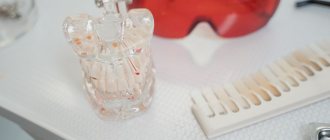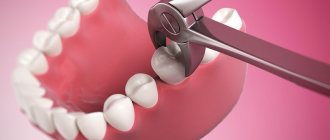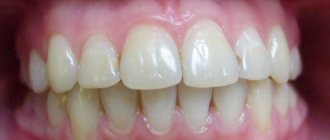We do not just a lot, but a lot of similar operations. People come from other cities, even from other countries, to get rid of annoying eights in Moscow, but we don’t understand why such a simple operation cannot be done in our city.
When asked why they needed to come to us, patients answer that they are afraid to do it anywhere else.
In one clinic they are offered to do everything at once and under anesthesia (which, to put it mildly, is very expensive and very unsafe).
In another, they almost guaranteed a nerve injury with all that it entails. Moreover, it is assumed that this should “distort the face” - pure incompetence and lies.
In the third, they demand to buy biomaterials for the holes - a waste of money and simply a dangerous procedure.
In the fourth medical institution they promised to remove the wisdom tooth in 3-4 hours, bringing this trivial operation in complexity and duration to coronary artery bypass surgery.
Why do you want to have your wisdom teeth removed with us? Because we don't do any of that!
Anesthesia.
To remove even the most difficult wisdom teeth, local anesthesia is sufficient.
Firstly, it is as safe as you can imagine and is suitable for absolutely everyone. Properly administered local anesthesia is at least several hours of persistent pain relief, sufficient to not only remove wisdom teeth, but also perform rhinoplasty and mammoplasty as a gift.
Secondly, local anesthesia has one significant advantage. In our opinion, the most important thing is maintaining verbal and non-verbal contact with the patient. Local anesthesia and preservation of all cognitive functions, at a minimum, eliminate treating the patient like a piece of meat - we feel you, worry with you and strive to cause as little discomfort as possible. A number of researchers have studied the morbidity and incidence of complications, comparing operations under local and general anesthesia, and the results of the studies were far from in favor of the latter. And there is an explanation for this. The lack of reactions on the part of the patient under sedation “frees the hands” of the surgeon; direct and feedback connections are lost between him and the patient - because of this, the traumatic nature of the operation increases sharply.
For local anesthesia when removing wisdom teeth, we use anesthetics familiar to all dentists. Mainly based on Articaine - as the most effective and safe.
Is it painful to remove a wisdom tooth?
Most people are afraid of pain during surgery, not post-operative complications. Removal is usually performed under local anesthesia, which “freezes” the tissue. It is sufficient for painless surgical treatment. Modern clinics use the drugs Ultracain or Septanest, which provide a freezing effect within a few minutes after injection into the gums.
If the patient experiences severe fear or the operation is complex and time-consuming, then general anesthesia is performed. Anesthesia completely turns off the patient’s consciousness, so he does not feel anything and does not remember about the procedure. Treatment under anesthesia is carried out in the presence of an anesthesiologist, who determines the dose and monitors the patient’s condition at the time of surgery.
Nerve damage – is it possible?
I’ll say right away that under general anesthesia it’s absolutely possible. Due to the same increasing morbidity.
The correct technology for removing wisdom teeth does not involve approaching the nerve trunk closer than 5 mm. Correctly formed access, opening and fragmentation of the tooth excludes access for cutting and sawing instruments to the apex of the wisdom tooth root, next to which the nerve usually passes. And during the removal process, you cannot make significant physical efforts, you cannot use a hammer and chisel (unfortunately, this still happens in some places). And then everything will be fine with the nerve.
Rarely, and in some patients, paresthesia still occurs after tooth extraction. It may be due to injury to the nerve trunk during anesthesia or swelling compressing the nerve in the area of surgery. After some time, sensitivity is restored. There has never been a time when she did not recover. It just takes time. Which? Alas, the process of restoring sensitivity takes different times for everyone. Some people need a couple of days, others a couple of months. But paresthesia always goes away - that's a fact.
Indications for wisdom tooth removal
1. Dental dystopia.
The highest percentage of complications is caused by atypically growing wisdom teeth. Dystopia manifests itself as a deviation from the normal position. A common cause of dystopic third molars is lack of sufficient space. Eights are massive and require a lot of space for proper placement, and modern humans have relatively compact jaws.
As a result of the uneven growth of eights, the following negative situations arise:
- Chronic cheek injury (erosions, ulcers, hyperkeratosis).
- Hidden caries.
- Formation of periodontal pockets.
- Disorders of the mandibular joint.
2. Tooth retention.
When unerupted third molars exist under the gum, they are called impacted. If they erupt partially, they are semi-retinated. With complete retention, the figure eight may not bother its owner, and it is accidentally detected on an x-ray.
Partial retention is fraught with unpleasant consequences, including:
- Inflammation of the gingival hood;
- Periostitis (flux);
- Tooth cyst;
- Hidden caries.
Third molars can exert pressure on neighboring teeth, which is transmitted along the “chain” along the entire row. Sometimes even the incisors become deformed due to their fault. The growth of impacted eights displaces teeth after orthodontic correction. Therefore, before treatment with an orthodontist, it is advisable to get rid of them.
Other reasons.
- Normally erupted third molars are removed for the same reasons as the remaining teeth:
- Presence of perihilar cysts;
- Volumetric destruction of the crown or root system that is not subject to therapeutic treatment;
- Mobility 2-3 degrees;
- Injury.
Why do you need to place an artificial bone in the figure eight hole?
The purpose of this procedure is one thing - to shake out more money from you, otherwise the doctor has a car loan and a mortgage. Even the most expensive biomaterials placed in the sockets of wisdom teeth do not play any useful role; their use does not carry any meaningful meaning. But it can be worse - they often fester and complicate the course of the postoperative period, leading to very sad consequences. In other words, you cannot use “artificial bone” when removing a wisdom tooth. Even if you really want to.
The most we use are collagen sponges soaked in anti-inflammatory compounds. They help stop socket bleeding and minimize inflammatory symptoms (primarily pain) immediately after removal. And they stand... they cost almost nothing.
Consequences of wisdom tooth removal
Complications may occur during or after surgery. During removal, the adjacent tooth, gums and nearby tissues may be damaged, the alveolar process may break, and the maxillary sinus may perforate. Such consequences arise due to the inexperience of the doctor or time constraints when the surgeon performs the operation quickly due to a large queue of patients. In order to avoid complications, you need to choose a reliable clinic where the patient can devote enough time.
After the tooth has been successfully removed, the patient still faces difficulties. The main ones are pain and swelling, but they go away after a few days. Severe pain can be reduced with analgesics. Antibiotics are prescribed for wisdom tooth removal if there is an inflammatory process.
Common complications include:
- bleeding from the socket;
- hematoma;
- alveolitis - inflammation of the socket;
- increased body temperature;
- loss of sensitivity (paresthesia) in nearby areas - cheeks, gums, chin.
Many patients rinse their mouth thoroughly after surgery, but this should not be done. A blood clot forms on the hole, which protects the wound surface from infection. If it is washed out, a dry socket effect occurs, which leads to tissue infection. Alveolitis requires surgical intervention.
Content
- When to remove a tooth
- What is recommended to do
- Stages
- What to do after deletion
- Remove wisdom tooth
- Prevention
- Final recommendations
PROMOTION
Inexpensive tooth extraction
from 1000 rub.
Tooth extraction at home is an unsafe event, as there is a high risk of infection. But there are situations in life when it is not possible to seek qualified help. Is it possible to pull out a tooth yourself and avoid complications?
How is wisdom tooth extraction performed?
Based on the figure eight state, the dental surgeon chooses a simple or complex surgical intervention algorithm.
Easy removal
It is used in case of a typical location of a wisdom tooth, if its coronal part is sufficiently preserved. For example, the 8th teeth can be removed in this way in case of periodontitis, when damage to the cement leads to their loosening. The duration of the operation is influenced by the structural features and branching of the roots. If there are no difficulties, the procedure takes about 20 minutes.
Sequencing:
- Anamnesis collection. At this stage, a survey is conducted to identify common diseases and contraindications.
- X-ray diagnostics. From the image, the doctor assesses the orientation and condition of the root system.
- Local anesthesia. The type of anesthetic injections for removal is selected taking into account allergic reactions and personal intolerance.
- Using special instruments, the gums are peeled off to prevent soft tissue injury.
- The surgeon rocks the tooth while holding it with forceps. This destroys the ligaments that firmly hold it in the bone.
- Direct tooth extraction.
- If there are bone fragments left in the hole, they are carefully removed.
- After treatment with antiseptics, an anti-inflammatory medicine is placed in the hole.
- If during the operation a large cavity with damaged edges is formed, the wound is sutured.
Difficult removal
When it is not possible to extract a tooth with forceps, you have to resort to a special surgical technique. Candidates for complex removal are impacted and dystopic wisdom teeth. In such situations, they are accessed through an incision in the gum.
Such manipulation causes unreasonable fear in patients, but there is no need to be afraid of it. It is performed quickly and absolutely painlessly. Problem eights that are not removed in time cause much more trouble.
Stages of complex tooth extraction:
- Anesthesia.
- Gum cutting. If the tooth is “hidden” deeply, the mucoperiosteal flap is peeled off.
- A hole is drilled in the jawbone using an ultrasonic instrument or bur.
- The tooth is extracted.
- If the figure eight is large in size, it is divided into parts and each fragment is extracted separately.
- An analgesic and regeneration-accelerating drug is placed into the cavity.
- Stitches are applied.
Indications for tooth extraction
• The crown of the tooth has chipped deep under the gum.
• Cyst at the root apex.
• When there is resorption of bone tissue between the roots of the tooth.
• Serious jaw injury.
• Longitudinal tooth fracture.
• Severe tooth mobility.
• Third molars (“wisdom teeth”, “eights”).
• Chronic inflammatory process in bone tissue.
• Recommendation by an orthodontist in the treatment of malocclusion (for example, severe crowding of teeth).
What not to do
Sometimes our dental clinic is asked to remove a tooth, citing immediate savings in time and money. Although upon examination it turns out that the tooth can be cured. Naturally, treating a neglected tooth is more expensive than removing it and may require several visits to the doctor. Most lovers of this “non-treatment” are young people under 25 years old.
Perhaps they think like this - no tooth, no problem. It's a delusion. Nature abhors a vacuum! For example, if a tooth is removed, the two adjacent ones will necessarily bend over to fill the gap. Therefore, after tooth extraction, implantation and prosthetics are necessary for a short period. And this will be much more expensive and longer than treating a tooth in time.
Wisdom tooth removal
If pulling out a baby tooth at home is not a particular problem, then with a wisdom tooth things are different. This dental unit can be removed only if it can be firmly grasped and loosened. Cutting the gum is prohibited so as not to damage the nerve of the lower jaw. For convenience, you need to place a tampon between your gum and cheek. “Eights” have longer roots, so independent removal is almost impossible. This procedure must be performed in a specialized institution.
When it is prohibited for an adult or child to pull out a tooth at home:
- If the gums are very swollen and there is no way to act carefully;
- With purulent abscess, with gumboil;
- If a person has a fever;
- If the tooth is crumbled;
- With excessive sensitivity.










